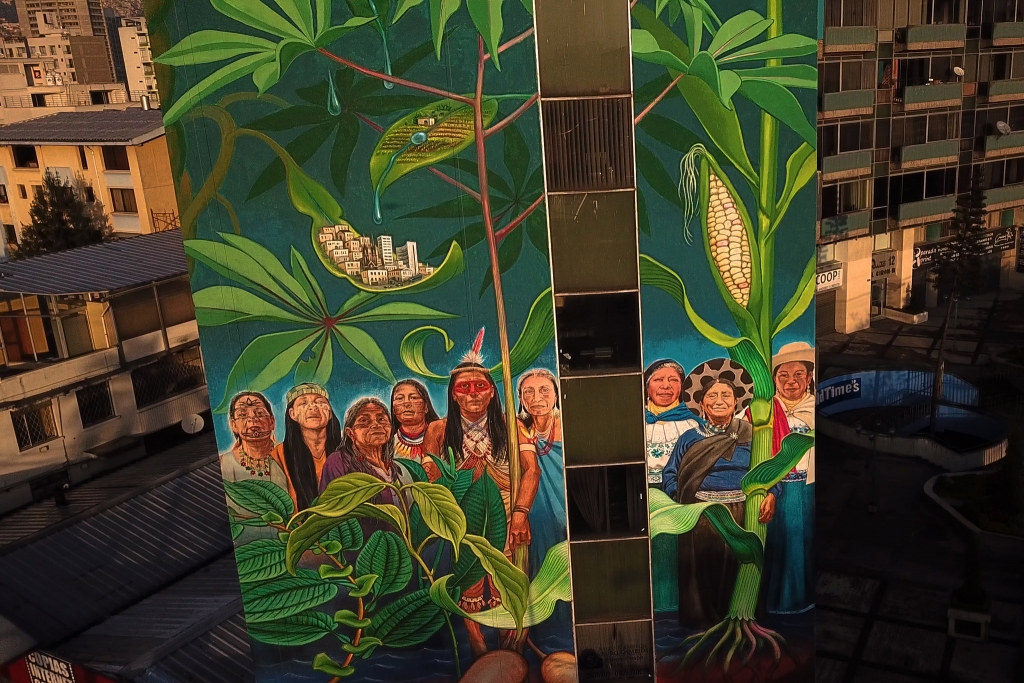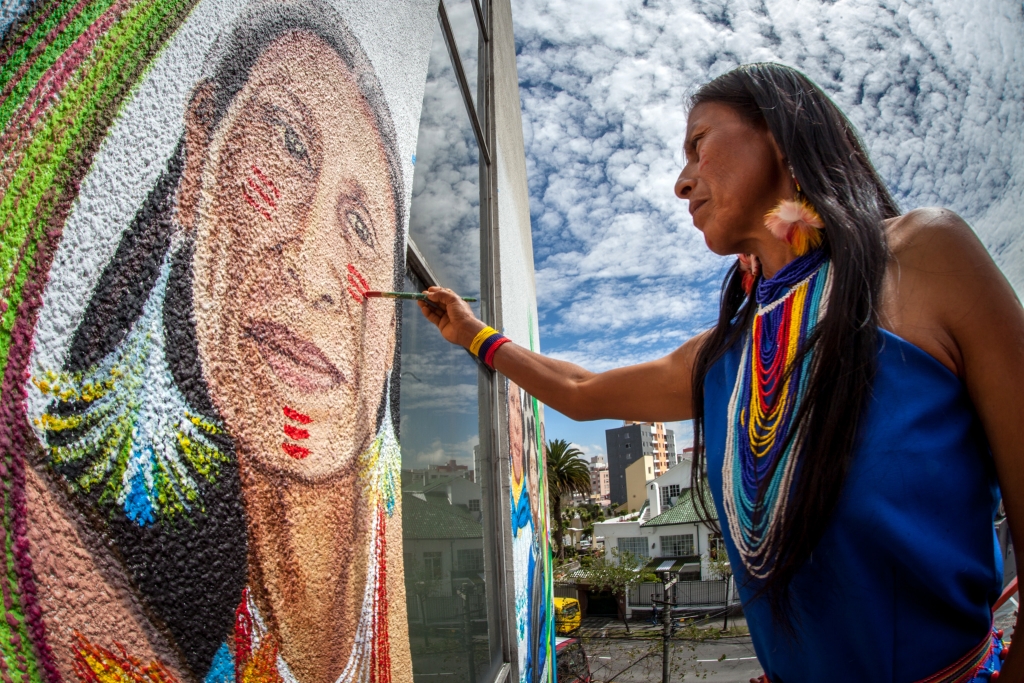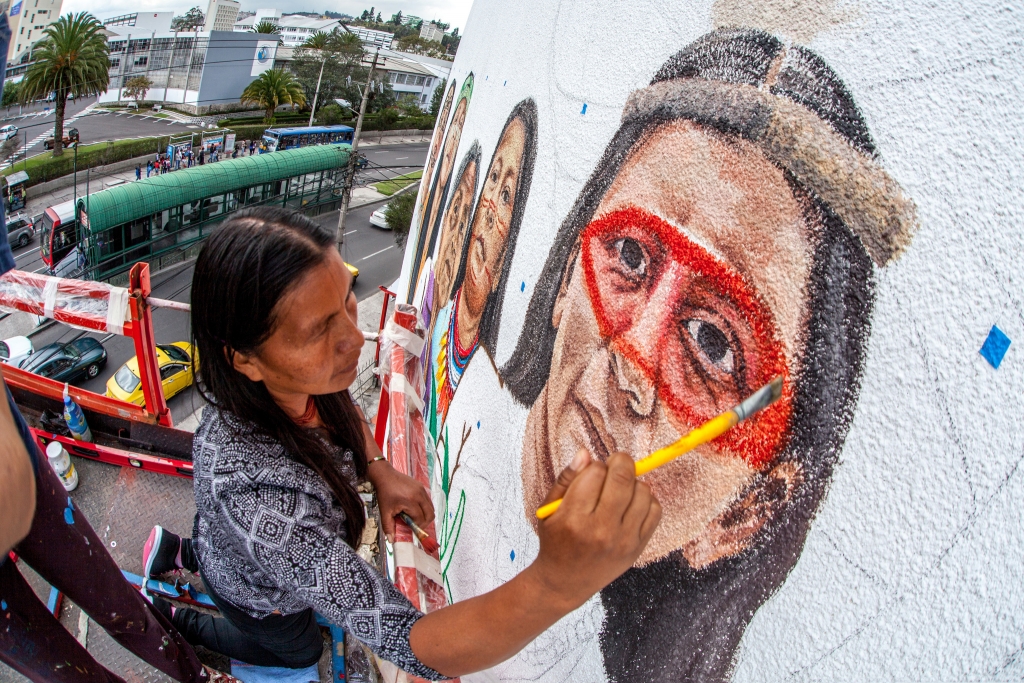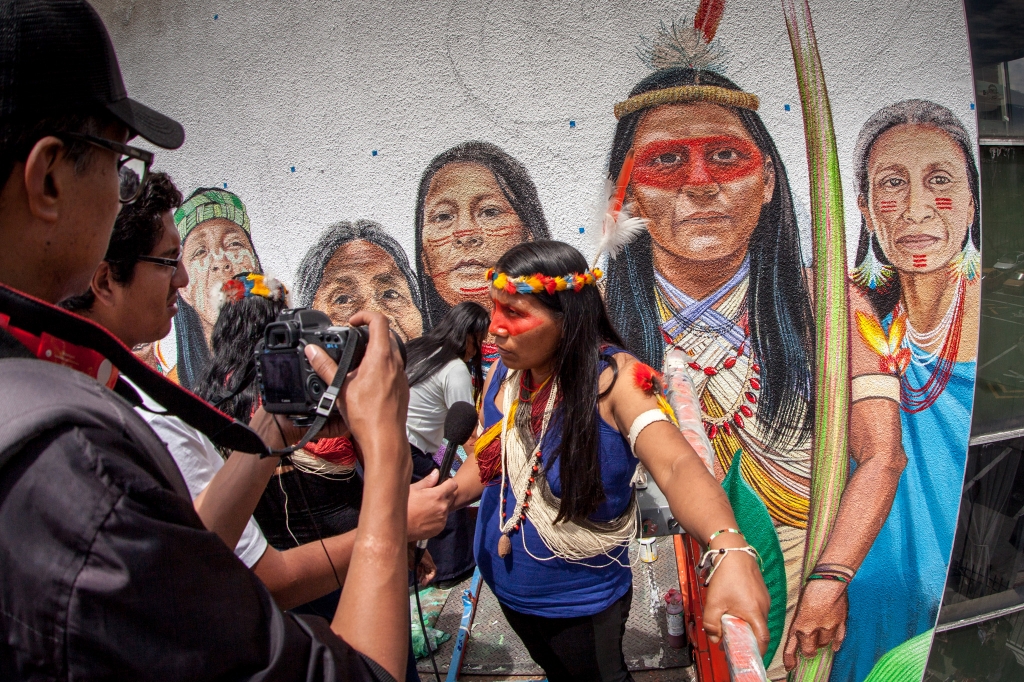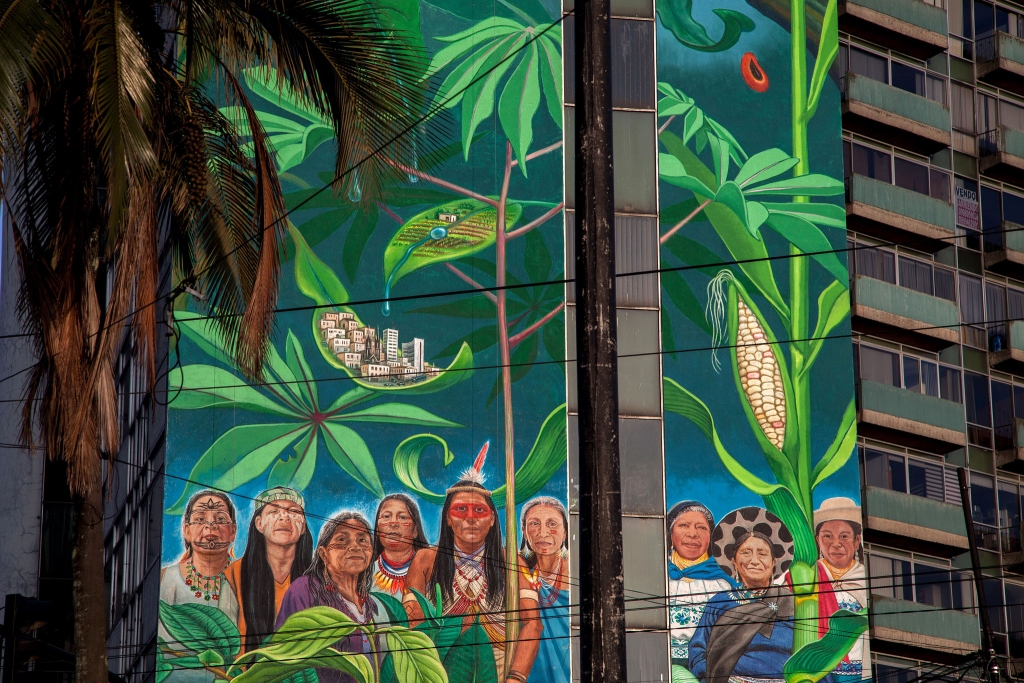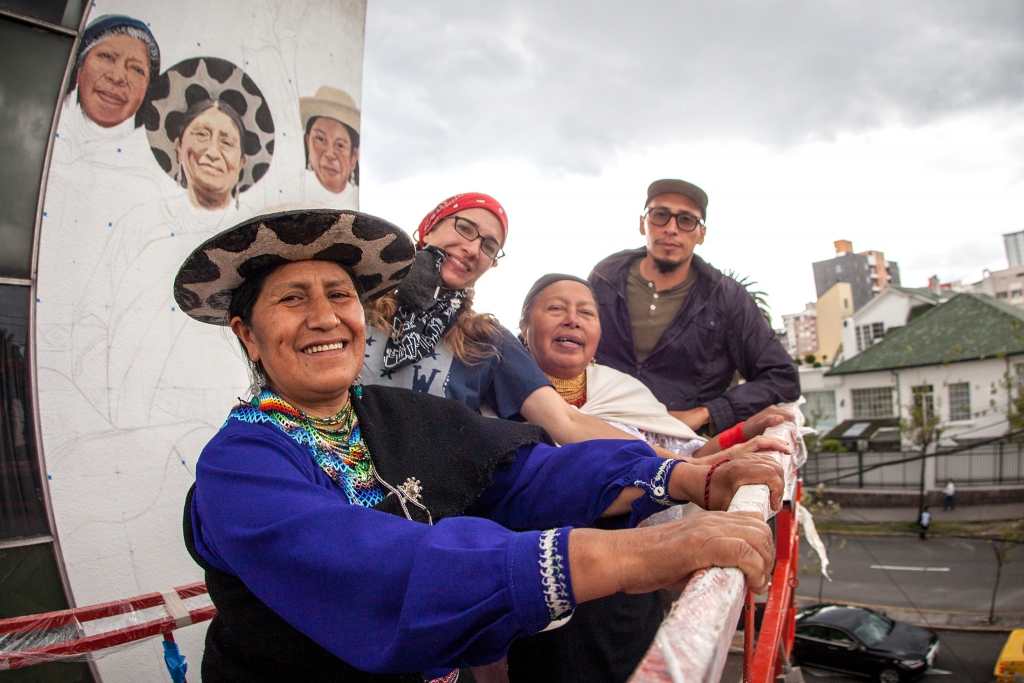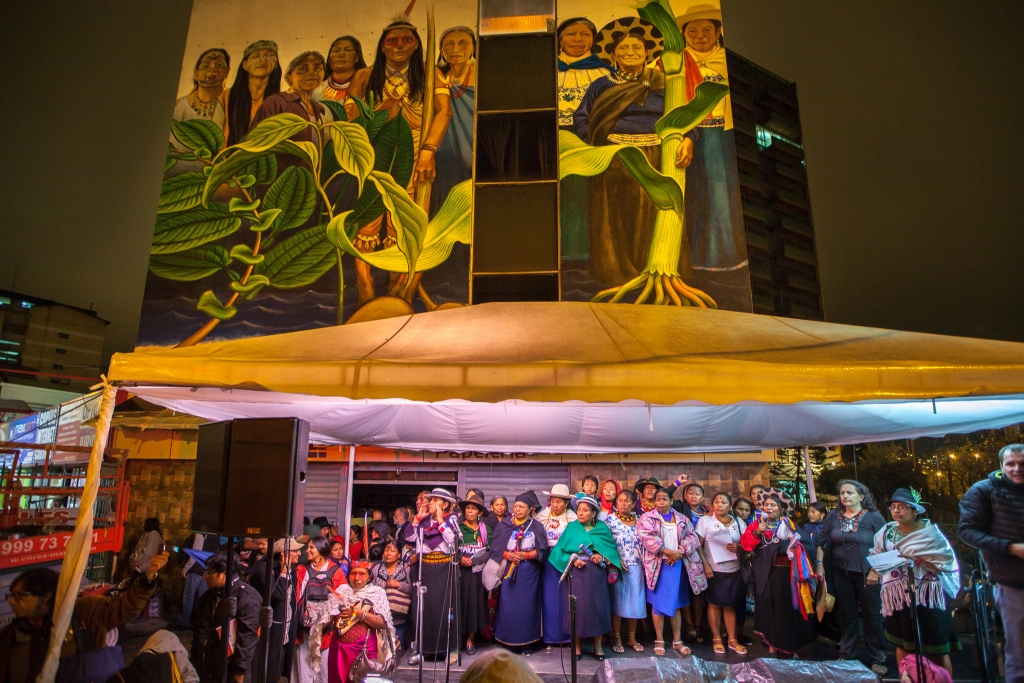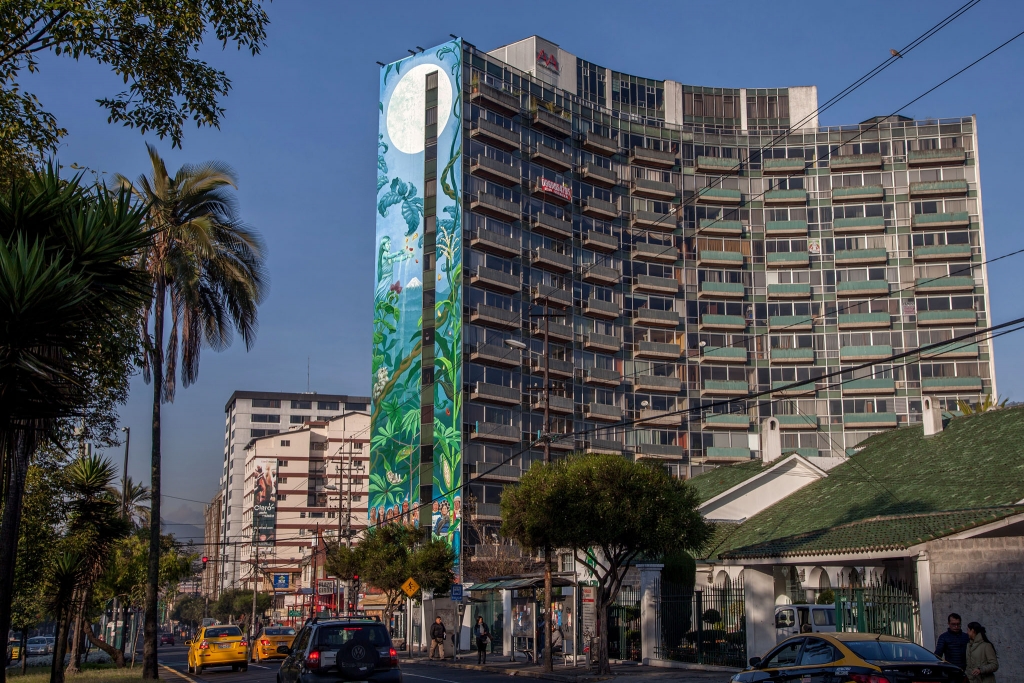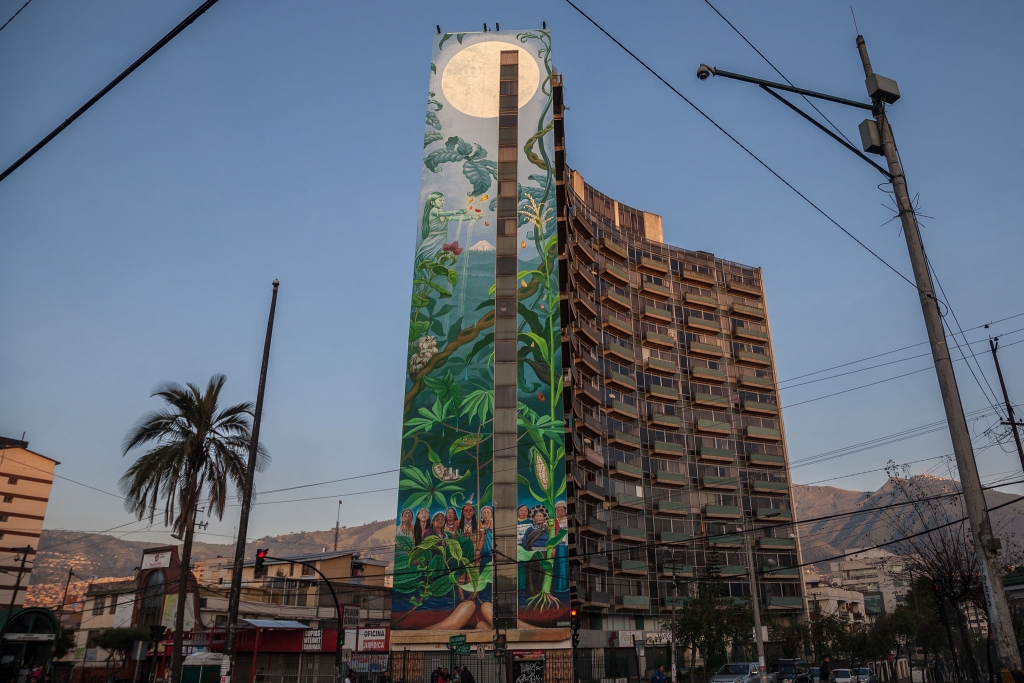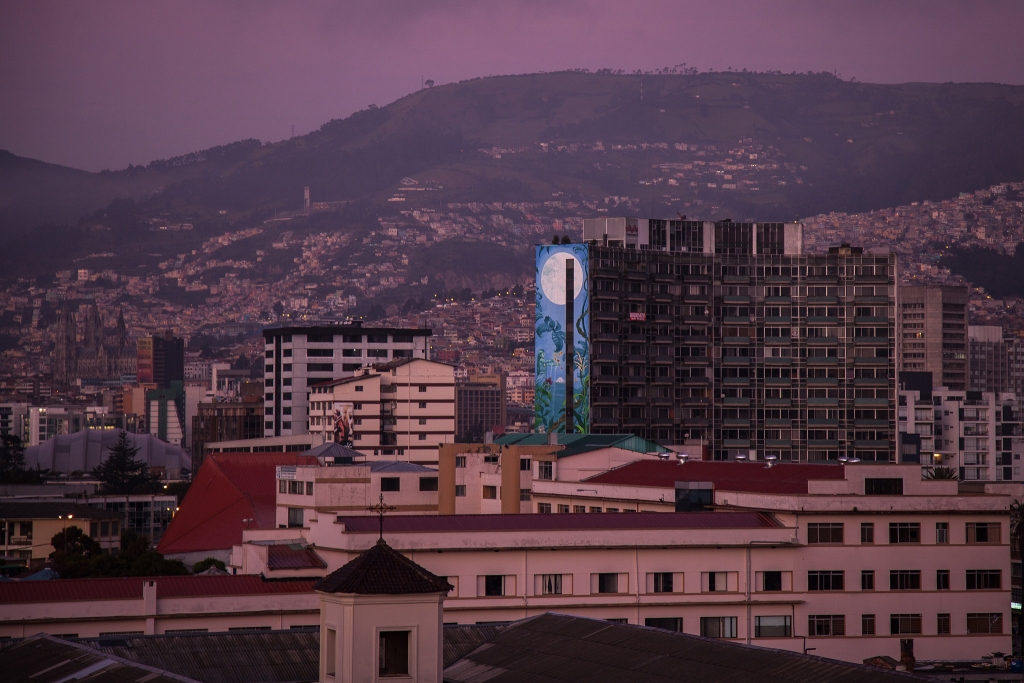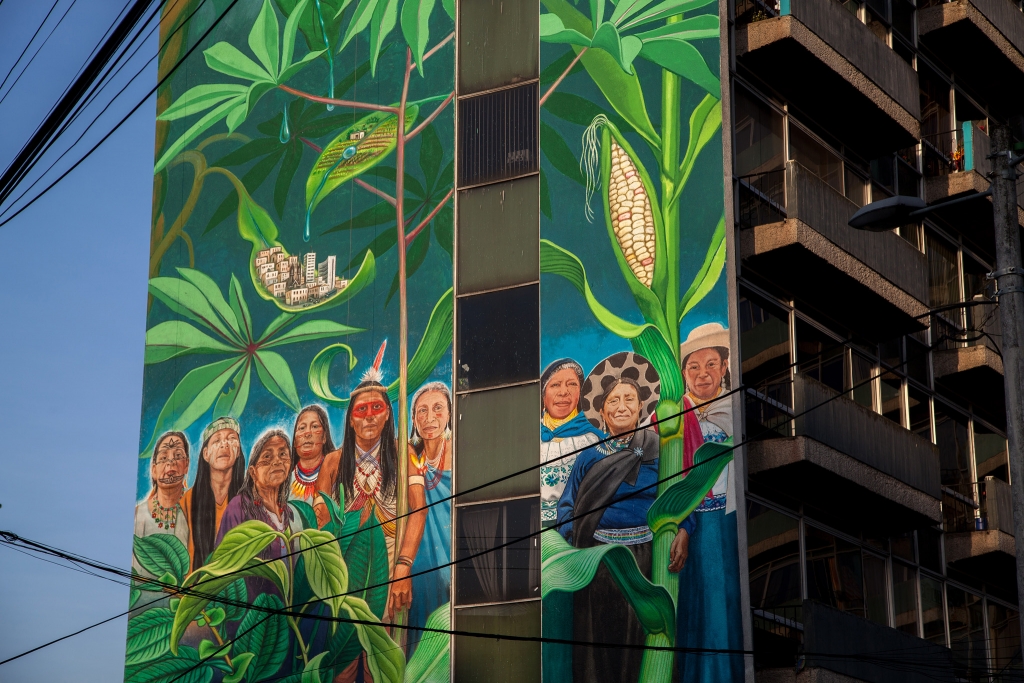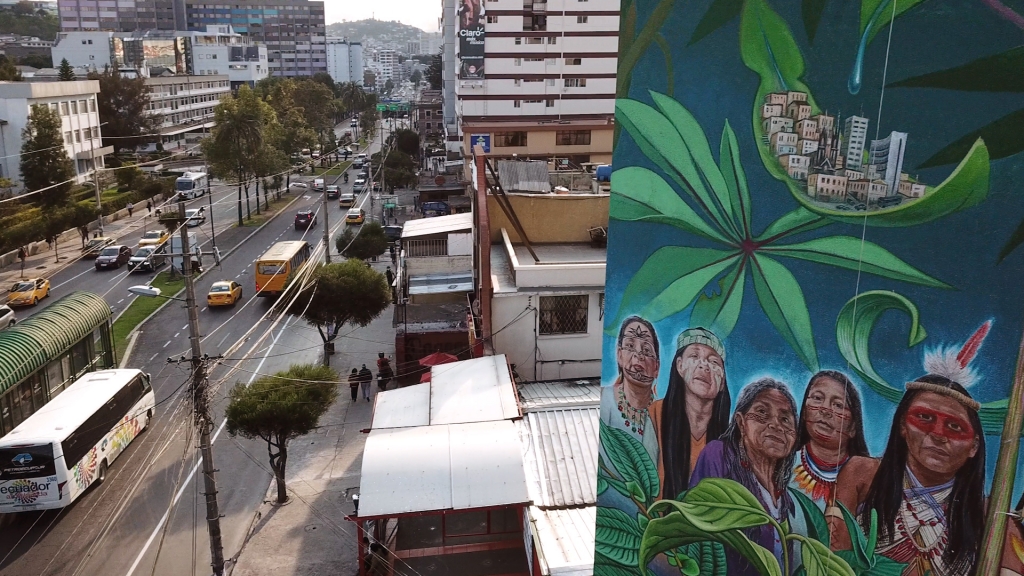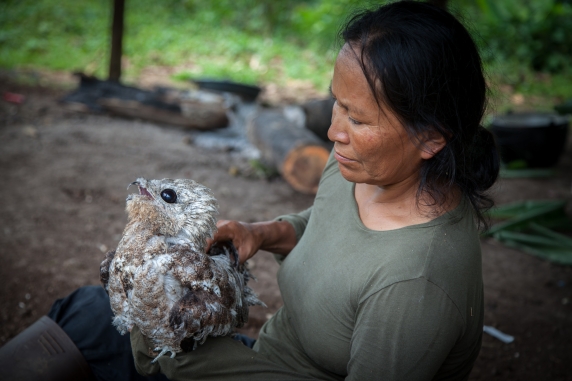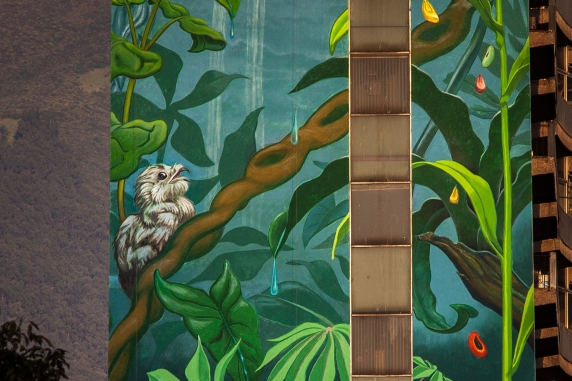Mujeres Custodias: Women Protectors of our Endangered Habitat
A mural in central Quito, Ecuador, created to raise the profile of 6 Amazonian and 3 Andean indigenous territories and the women leading their defense from fossil fuel extraction, mining projects, and agricultural laws that threaten food sovereignty and erase ancestral culture.
The mural’s content was determined in meetings, interviews, storytelling sessions and explorations in the Amazon and in a small Andean community near Otavalo, conducted with active protectors from indigenous frontline communities and Mona through the facilitation of members of Acción Ecologica, Tierra es Vida, Voces del Maís and Saramanta Warmicuna.
The artwork of the mural itself was undertaken by Mona Caron in collaboration with Raúl Ayala, artist and activist from Quito. Additional help came from David Ceballos and members of the Minka Urbana.
The women depicted in the mural are 6 Amazonian and 3 andean indigenous women who were chosen by their piers during the mural concept meetings.
From left, they are: Zoila Castillo, Gloria Ushigua, Cristina Gualinga, Rosa Gualinga, Alicia Weya Cahuiya, Dominga Antún, Blanca Chancoso, Carmen Lozano, Josefina Lema.
The first phase of the painting was conceived as an art-occupation during the UN conference on sustainable urban development Habitat3 in late 2016, from which these protectors of land, water, seeds, and culture had been excluded. The mural-in-progress was presented after an impressive march and rally at the mural, breaching the "green zone" imposed around the conference sites.
The mural's second phase in 2018 saw the extension of the mural upwards, to cover the landmark Girón Building’s entire 50 meters, with images of the common good being defended by these women: the water, land, air, and biodiversity, as well as the cultural and spiritual wholeness at stake in the defense of their sovereignty.
The Mural imagery
The women custodians are standing at the roots of all vegetation, and are holding, like standards, the stems of their most important food crops: yuca and corn. Behind them, the wilderness rises, and from within it emerge images from indigenous legends. These references to the cosmology of an endangered oral tradition are placed in an interplay with images of the modern western world, interrupting the magic with connections to the here and now.
The figure of a green girl borne out of foliage represents a version of the myth of Nunkui, which a Shuar grandmother once told Raúl Ayala. It was a legend about the origin of the Shuar people's knowledge in agricultural and foraging practices, and is a parable about the importance of biodiversity and variety in crops, and about the consequences of greed and the dangers of relying on a single crop for survival.
Hence, a diversity of seeds fall from Nunkui's hands, connecting the Amazonian with the Andean side of the mural, to the right of the windows, where the Andean women currently fighting the so-called "Monsanto law" stand...
The same giving figure doubles as what can be interpreted as the Pachamama, including Andean culture within this Amazonian-inspired image.
In addition to the seeds, from her hands also falls the equally precious gift of water, which sifts down through the forest, and eventually irrigates a tiny agrarian landscape cradled by a leaf, and drips onto a precarious-looking city, depicted as literally sustained by the forest.
The little city contains a simplified Quito Basilica, as well as the same Girón building that the mural is painted on, along with the smog-spewing traffic in front of it, bringing the whole scene back to the contemporary city where the mural's viewers find themselves, so distant but wholly impacted by what happens to nature.
An additional legend obscurely referenced to in the mural was told to Mona by Manuela Dagua deep within Sápara territory. It was about a nocturnal bird they call iluku, and is an origin myth of the moon and of a wavy forest vine called Ilukuchaka, "the stairs of the iluku".
It was a witty parable about the consequences of greed and subterfuge, explaining why the iluku bird can be heard crying so sadly in the Amazon during full moon nights.
The day after Manuela told that myth, they stumbled upon an injured iluku in the forest, very rarely seen by day or at all. The bird was drawn into the mural from the photos Mona took of the bird in Manuela's arms.
A mural as a tool of direct action
The sundry connections that brought about this mural were forged through friendships that stem back over previous years working in art-making for climate justice actions.
Mona's friendship with Raúl stems from when they were both ;making art for the People's Climate March and Flood Wall Street in New York, and those with other ecuadorean and indigenous activists at COP21 in Paris, among other events. After those summits, there had been an intention to de-centralize actions away from northern capitals and closer to the hotspots of frontline struggles.
This mural was sparked by the news, shortly after COP 21, that bloc 79 and 83 of the southern ecuadorean Amazon, covering most Sápara territory, had been auctioned off to Chinese oil companies. Almost in the same breath, it was announced that the Ecuadorean capital was going to host an international conference on sustainable urban development called Habitat 3.
The first phase of the mural was thus used as a space-opener during the UN conference Habitat 3. The mural site was chosen for its location within the conference's "green zone" in which no protest marches were allowed, in order to nonetheless establish a prominent presence of the indigenous people opposing extractivist projects, whose participation in the conference had been denied. Flyers were posted and handed out describing who the mural represents.
A march during the conference was attempted and blocked from reaching the mural, however a subsequent press conference at the mural effectively became a spectacular rally. Unfortunately, unprovoked physical attacks by riot police did occur nonetheless against people who had gathered in unexpectedly large numbers to listen to the women speak.
Mural concept development
The mural’s content was determined through meetings, interviews, storytelling sessions and explorations in the Amazon and in a small Andean community near Otavalo.
Despite the mural's origin as an art-action during a specific event, it was of course designed as a long-term artwork that would elevate timeless and primordial values that transcend the narrow value system of capitalism, and honor the decades of commitment to their defense by many indigenous from both the Amazonian and Andean regions.
-
1. In the Amazon:
The idea of representing a number of real persons in the mural was decided over two gatherings in the Amazonian town of Puyo, where Mona took notes of the opinions of frontline activists and allies from Saramanta Warmicuna, Tierra es Vida, Acción Ecologica.
The people at the gathering decided whom to represent in the mural, mostly on account of their seniority in their struggle to preserve their land from oil drilling and seismic exploration, in each the Huaorani, Kichwa, Shiwiar, Sápara, and Shuar territories.
Some of the mural's details within the vegetation were observed and suggested to Mona during research walks in Sápara territory, in the Amazon.
Once it was decided who was to be featured in the mural, Mona was able to take reference photo portraits of most of the women, after they had a chance to prepare and wear any adornments they wished to be represented with.
Mona then suggested that for representation justice, it should be a local artist to paint their faces, and that the women themselves should finish them by adding their own traditional face painting onto them, which no one has the right to do other than themselves.
This way, each person wielding a brush at the mural had a justified place, coming from concentric circles of geographic proximity to the threats faced by the Amazon, reflecting the full spectrum of local, regional, and planetary concern of these issues. This is when Raúl Ayala joined the project and brilliantly executed the portraiture. Mona's painting of hairstyle to jewelry and clothes was at times corrected or altered live over Whatsapp messaging by the portrait subjects.
The women's appearances at the mural to paint their faces eventually drew the press. At reporters' questions about the mural, they were directed to ask the mural's subjects directly.
-
2. In the Andes:
The Andean women represented in the mural are fighting for food sovreignty and cultural preservation as they resist the "Monsanto Law" curtailing the exchange of "un-standardized" heirloom seeds.
The introduction of transgenic GMO seeds, including "terminator seeds" that become sterile and require re-purchasing by the farmers, is part of a proposed law that would also require all agricultural seeds to be lab tested and certified for homogeneity and "safety", effectively curtailing the indigenous small farmer's practice of free seed exchange and small-scale diversified production.
Here is a video of the voices of the Andean activists portrayed in the mural in regards to this topic, shot at one such indigenous seed exchange in Mojandita, Otavalo Province.
The interviews were filmed by Mona Caron in october 2016, in site visits with the organization Alianza Milpa and Voices Of Maíz. The "Monsanto seed law" is still being deliberated at the time of this writing (January 2019).
The photos below show a seed exchange in an Andean indigenous community, which the new rules would make illegal. Other photos show Blanca Chancoso and Carmen Lozano at recurring protests outside the government building in Quito, and Josefina Lema of Hampiripacha leading ritual in her community. These are the 3 Andean women activists represented in the mural. Learn more about them here.
[all photos on this page by Mona Caron]
The mural painting adventure
Below, some video testimony of what it was like for Raúl Ayala and Mona Caron to paint a 50 meter tall building at 10 thousand feet altitude...
Thank you to YASunidos for the drone footage. Other footage and video editing by Mona Caron. More on our Instagram! Follow @nantuayauma and @mona.caron !



